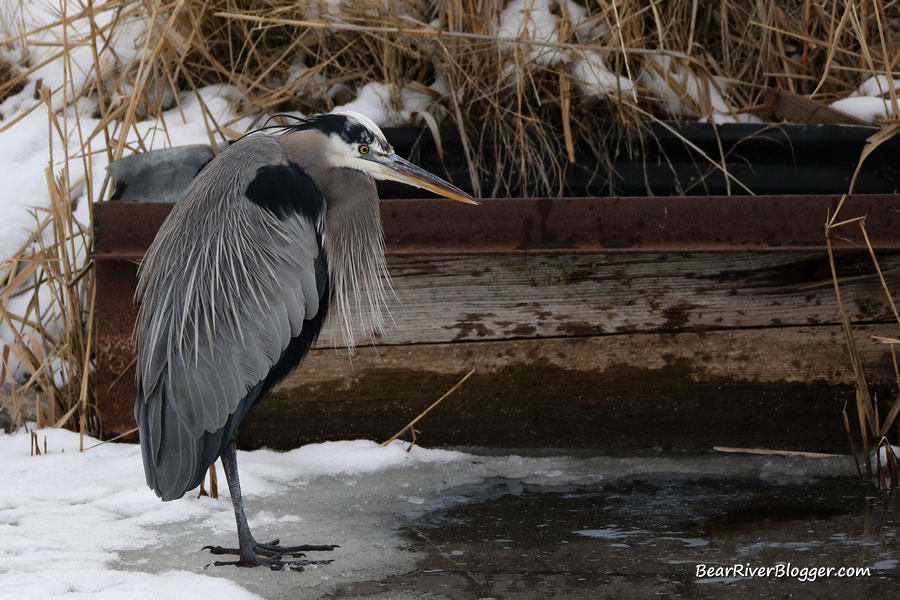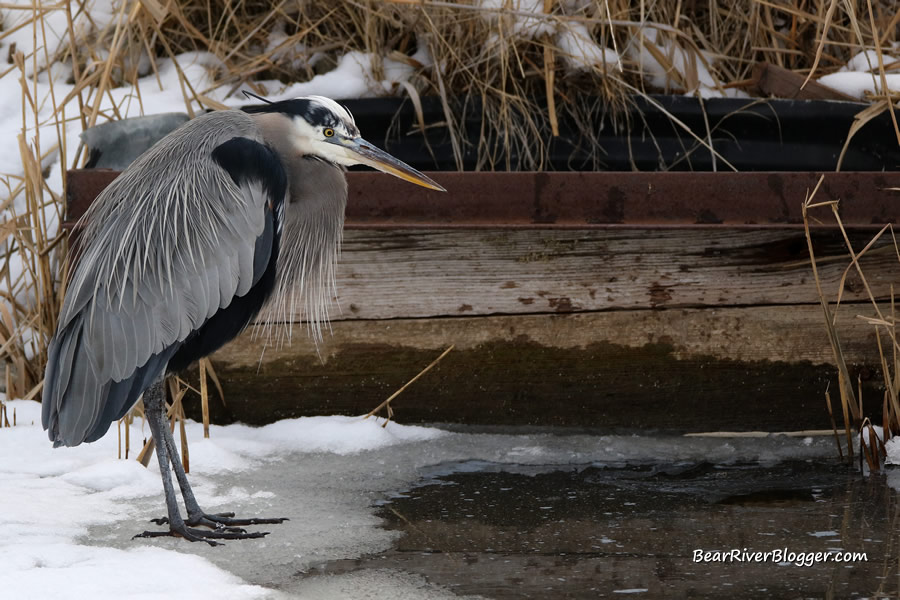When it comes to winter birdwatching there is one scene that, for me at least, fits the definition of an anomaly to a “T” and shows just how resilient great blue herons are in a very frigid winter climate.
It is also the absolute number one reason why I visit the Bear River Migratory Bird Refuge auto tour route so much during the coldest, harshest months of the year, particularly late December through the end of January to be more precise.
That scene I mentioned, pictured above, of course, depicts a great blue heron standing on a slab of ice, patiently guarding a small bit of open water in a very unpleasant environment as it waits, and waits, and waits some more, if needed, for an unsuspecting fish to swim by to become the heron’s next meal.
It’s an anomaly because even though great blue herons will eat rodents, snakes, small birds, muskrats, and just about anything else they can grab with their long and sharply pointed beak, if and whenever it is needed, they are primarily fish-eating birds.
As such, one wouldn’t particularly expect to find a great blue heron hovering over a small ice hole, sometimes for several hours if needed, in search of a meal while enduring sub-freezing temperatures but instead migrate south to a warmer and more temperate climate for the winter like many other birds do.
But great blue herons are very resilient birds and many of them have adapted to handle the cold and sometimes extremely brutal winters we have here in northern Utah instead of migrating south for the season.
About four years ago, sometime in early January to be exact, I had the notion to photograph winter birds on the Bear River Migratory Bird Refuge so I grabbed my camera gear, dressed as warmly as I could, and headed out to drive their famous auto loop to see what I could find and photograph for this website.
It was a very cold morning as the expected high temperature wasn’t going to rise anywhere near, let alone above, the freezing mark.
Sometimes here in Utah we get what is called an “arctic blast” where extremely cold air gets pushed down from Canada and settles in for a few weeks or so, causing the daily temperatures to do nothing but plummet and stay far below the normal range for a spell which, by the way, isn’t exactly warm to begin with during the month of January.
This trip to the bird refuge was one of those times as the morning started out with the thermometer on the back of the house reading in the single digits on a Fahrenheit scale.
But towards the bird refuge I drove anyway as this kind of weather can actually be pretty good for winter birdwatching and photography if, of course, you dress warm and can tolerate it yourself.
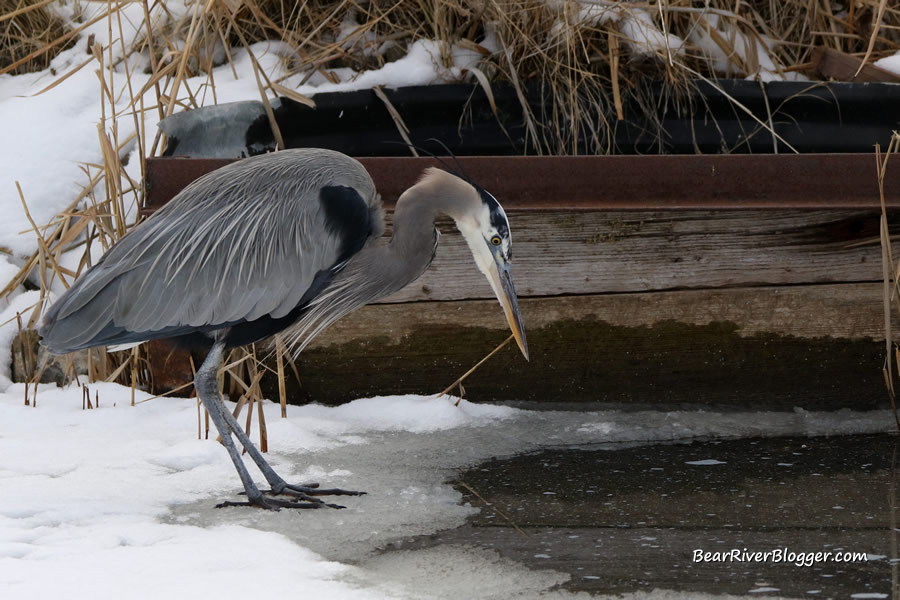
As I drove down Forest Street, before arriving at the main gate, my attention was quickly grabbed by a small and unexpected patch of open water in the canal on the south side of the road.
There a metal culvert was set to where it allowed a little water to continually trickle through the apparatus, somehow keeping a nearby small patch of open water from freezing by having just enough moving water flowing through the pipe.
And from what I have found from numerous winter trips to the refuge, anytime you find even the smallest patch of open water during the middle of winter like this keep your eyes open and your camera ready because you will commonly find, and I most certainly did here, a great blue heron standing over the open water in search of a quick and easy meal.
Winter birdwatching and photography isn’t about crossing paths with great numbers of birds like it is during the summer but rather just finding solitary, intimate moments like this and spending as much time as possible to see how the situation plays out.
Birdwatching during winter is about finding an interesting scene in nature and just enjoying it for a stretch of time, possibly learning from it as well, before moving on to the next one.
And sit for a spell I most certainly did with this heron.
I intently watched and photographed this particular great blue heron for over twenty minutes or more before heading out on the refuge auto tour route, only leaving the great blue heron behind because with the window rolled down and the engine turned off I was getting a bit, well, cold.
But before I left this particular heron to his own device, I was once again reminded just how resilient herons are and how they can survive such frigid temperatures here in Utah as they search for food, especially fish, in a frozen environment like this.
Great blue herons can and will stand perfectly still when waiting for a fish, sometimes hours at a time if needed, before plunging their head and sometimes entire body into the icy water in hopes of catching their next meal.
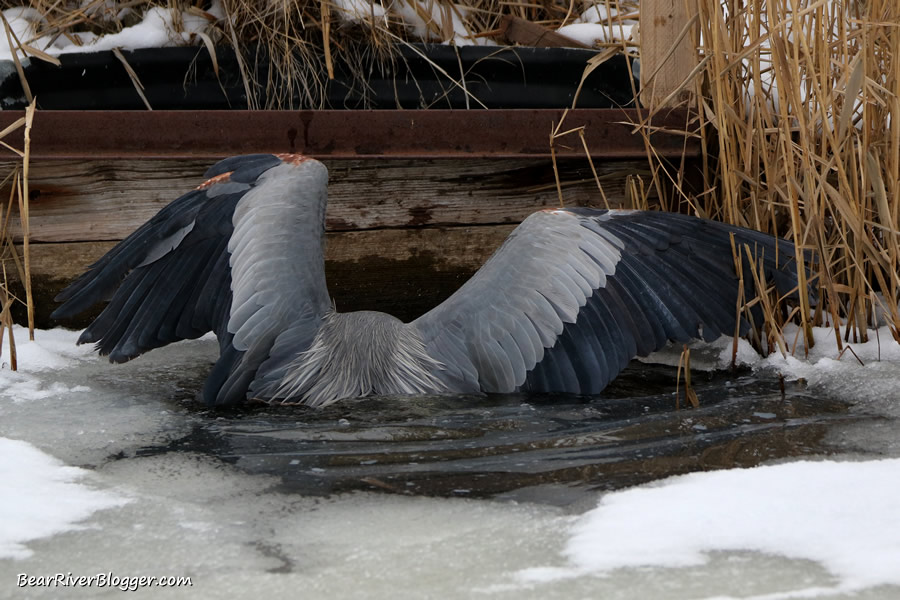
That’s exactly what this particular great blue heron did, thrusting himself into the small patch of open, icy water after a meal but, unfortunately, to only come up empty-handed at the end.
Without a fish for his efforts, the heron pulled himself back onto the ice, vigorously shook what icy water he could from his soaked plumage a few times, turned back towards the open water, and began to stand over the ice hole once again with a bit of optimism for the next opportunity that only a wet and hungry great blue heron on a frigid winters day could have.
This is exactly the reason why I photograph and share what I do on this website, hoping to not only entertain but even more so to enlighten and educate people about just how incredible nature really is.
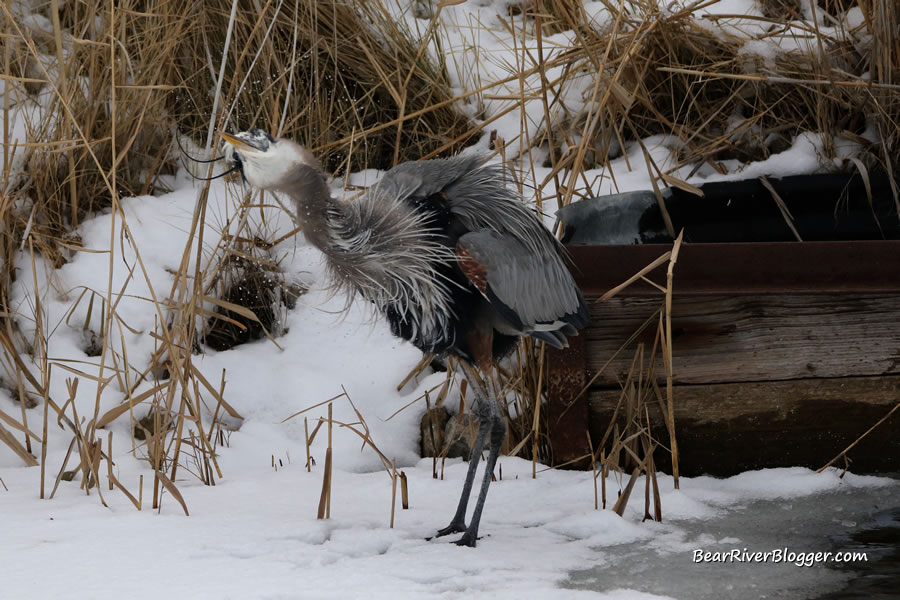
It has been said that the further north great blue herons are here in North America the more they are apt to migrate south for the winter but here in Utah great blue herons stay year-round as they have found ways to adapt to the cold, harsh winter climate as they search for food.
But the question remains just how do great blue herons avoid freezing to death in such cold temperatures when they have full-body plunged themselves into an icy marsh after a fish and are soaking wet as a result?
Like many birds, great blue herons have what is called a uropygial gland, also referred to as a preening gland, located at the base of their tail where they use their beak to extract oil from the gland and rub it all over their plumage, acting as a kind of waterproofing, if you will.
Simply put, this oil helps the water to run off the heron’s feathers much easier when the bird shakes and preens after diving into the icy water, thus helping the heron dry out and warm up as much as possible under these extreme conditions.
Typically, however, much of the time a great blue heron can just stab and reach with its long neck and beak to grab a fish out of a bit of shallow water like this, not having to always dive into the icy water as this particular heron did, but there are times where they will do whatever is necessary to secure food during a harsh winter.
So, after all is said and done, great blue herons are very resilient birds that have found ways to endure and adapt to some pretty harsh winter conditions and why I love birdwatching and photographing on the Bear River Migratory Bird Refuge so much during the coldest parts of winter.
If you’re like me, an avid birdwatcher and all-around nature enthusiast, I offer you to head on over to our subscribe page and sign up for email notifications for future blog posts like this one where we try to enlighten and entertain others about the fascinating creatures, birds or otherwise, found both on and off of the famous Bear River Migratory Bird Refuge.
Lastly, if you are looking for a gift for a fellow birdwatcher head on over to Bird Shirts and More and take a look at their growing line of t-shirts, sweats, hoodies, and other gifts for the nature lover or birder on your shopping list this year.

